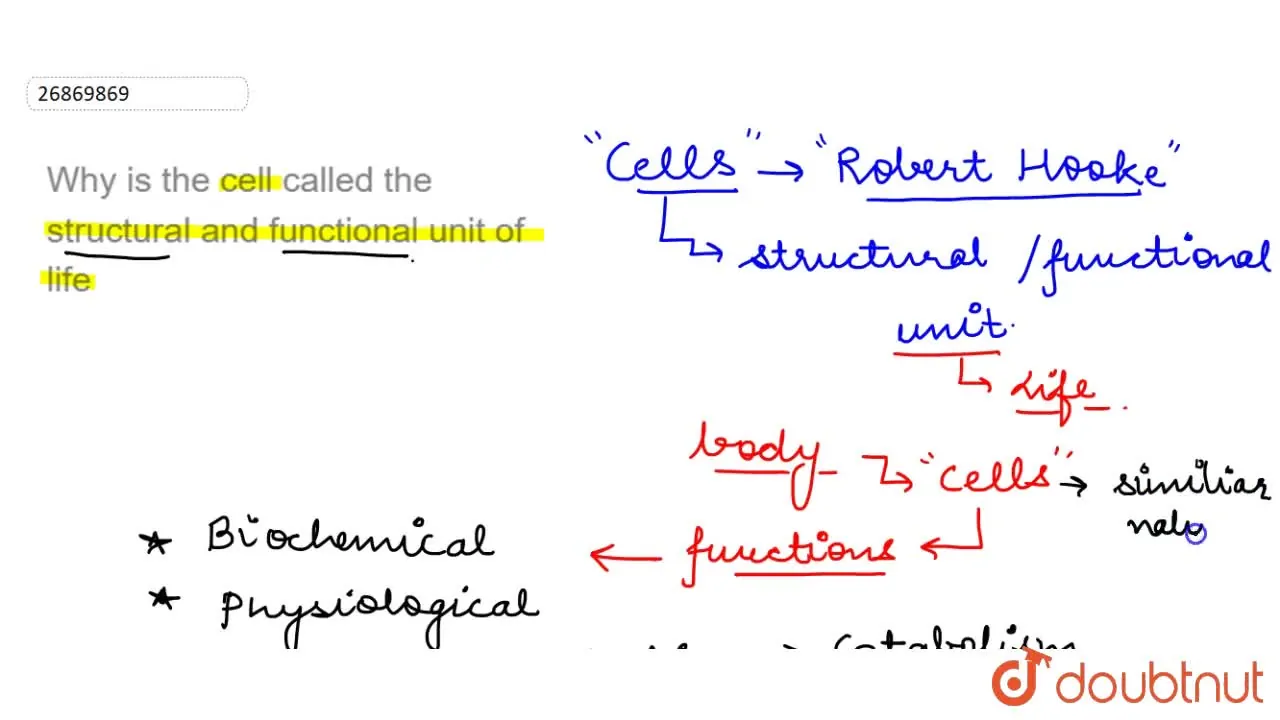Why is the cell called the structural and functional unit of life
The Fundamental Unit of Life
Cells are called the structueral functional unit of life because all the living organisms are made up of cells and also all the functions taking place inside the body of organism are performed by cells.
Cell is the smallest functional unit of life and it was in the year 1665 that Robert Hooke discovered it. A cell can perform all the different activities independently in order to sustain life. So, cell happens to be the basic unit of life. There are two types of cells → plant cell and the other one is animal cell. Let us have a look at their functions
Plasma/Cell membrane:
This helps in separating the contents of the cell from its external environment. Here, the plasma membrane helps in permitting the entry as well as exit of some materials which is known as selectively permeable membrane.
If the medium has the same water concentration as the cell, then it should be noted that no net movement of water would be found across the cell membrane. In this case, such a solution is known as isotonic solution. On the other hand, if the medium has a lower water concentration then the cell will lose water by osmosis. In that case, it is called hypertonic solution.
The plasma membrane happens to be flexible which comprises of organic molecules called lipids and proteins. It is the flexibility of cell membrane that’s helps in enabling the cell to engulf in food and other material from its external environment. This is called endocytosis. It can be observed in Amoeba.
Cell wall (Protective wall):
Cell wall is also known as protective wall that lies outside the plasma membrane. It is mainly composed of cellulose. It happens to be a complex substance which provide structural strength to plant cells.
Nucleus (Brain of a cell):
When it comes to the nucleus, it has a double-layered covering called nuclear membrane.
- Prokaryotic Cells: It has single chromosomes where such nucleus is known as nucleoid. Such cells are called prokaryotic cell.
- Eukaryotic Cells: It has got membrane bound cell organelle which is termed as eukaryotic cell. Such cells have more than one chromosome.
Cytoplasm:
The cytoplasm is the fluid content which is found inside the plasma membrane.
Cell Organelles:
The different components of cell perform different function and these components are called cell organelles.
(i) Endoplasmic Reticulum (ER) (Channels, Network for transport): It happens to be a large network of membrane-bound tubes and sheets. There are two types of ER-Rough endoplasmic reticulum [RER] and smooth endoplasmic reticulum [SER]. RER has particles called ribosomes attached to its surface. The ribosomes are the sites of protein manufacture.
The SER helps in manufacturing fat molecules, or lipids which is very important for cell function. Some of these proteins and lipids help to build the cell membrane and this is known as membrane biogenesis.
(ii) Golgi Apparatus (Packaging): The golgi apparatus, compromises of a system of membrane-bound vesicles arranged approximately, which is parallel to each other in stacks which is known as cisterns.
(iii) Lysosomes [Suicide bags] (Cleanliness of cell): This happens to be a kind of waste dispatch and disposal system of the cell. It helps in keeping the cell clean by digesting any foreign material as well as worn-out cell organelles. It is also known as suicide bags as well.
(iv) Mitochondria (Powerhouse, Energy provider): Mitochondria are widely known as powerhouses of the cell. The energy which is required for various chemical activities needed for life is released by mitochondria in the form of ATP [Adenosine Triphosphate] molecules.
(v) Plastids: It should be mentioned that this is present only in plant cells. There happens to be two types of plastids chromoplasts and leucoplasts. Chromoplasts are the coloured plastids which are present in leaves, flowers and fruits. Plastids contain the pigment chlorophyll which is known as chloroplasts.
(vi) Vacuoles (Storage): Vacuoles are storage sacs for solid or liquid contents. Vacuoles are small-sized in animal cells while plant cells have very large vacuoles [50% to 90% cell volume].
In plant cells, vacuoles are full of cell sap and provide turgidity and rigidity to the cell. In Amoeba, the food vacuole contains the food items that is consumed by it and contractile vacuoles expels excess water and some wastes from the cell.
Related Playlists
Similar Questions
Why is cell called 'the structural and functional unit of life'?
View SolutionThe structural and functional unit of liver is
View SolutionName the structure and functional unit of life.
View SolutionThe structural and functional unit of kidney is
View SolutionName the structure and functional unit of liver.
View SolutionName the structural and functional unit of the liver.
View SolutionSchleiden (1838) proposed that cell is the structural and functional unit of life. His idea was a
View SolutionThe structural and functional unit of organisms is
View SolutionThe structural and functional unit of kidney is called
View SolutionThe structural and function units of liver are called
View Solution


